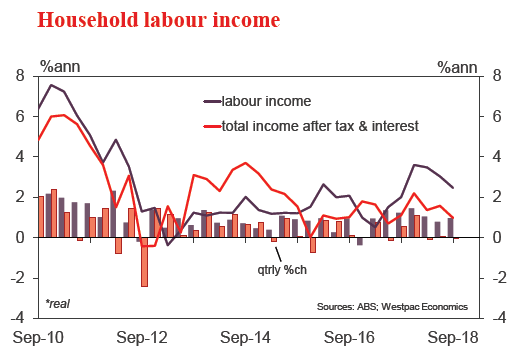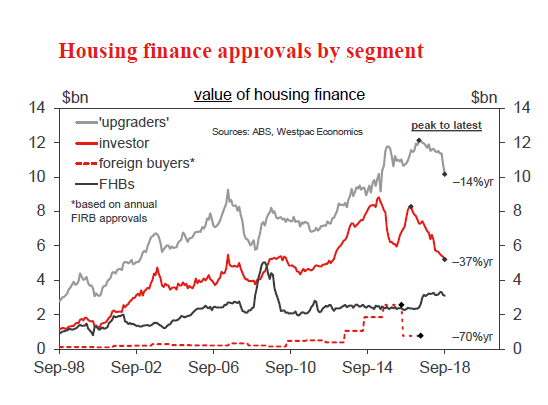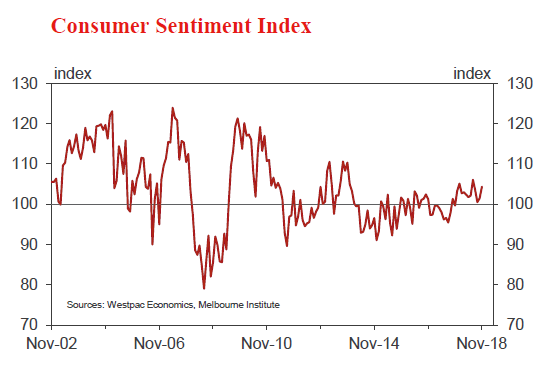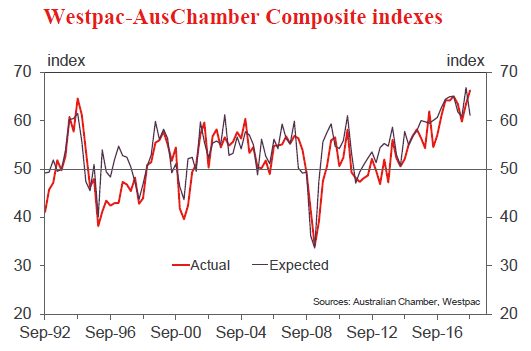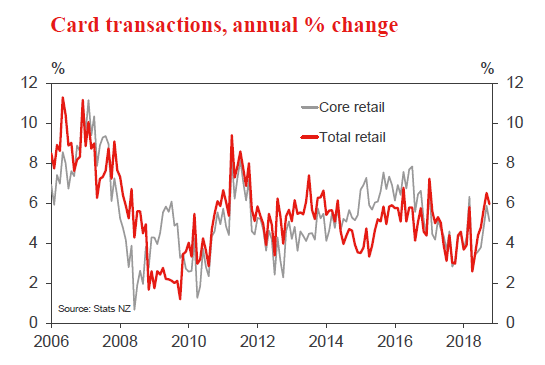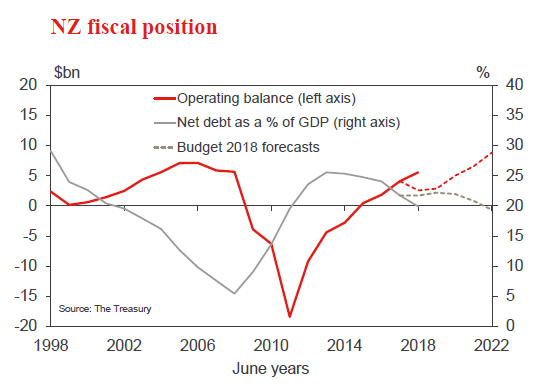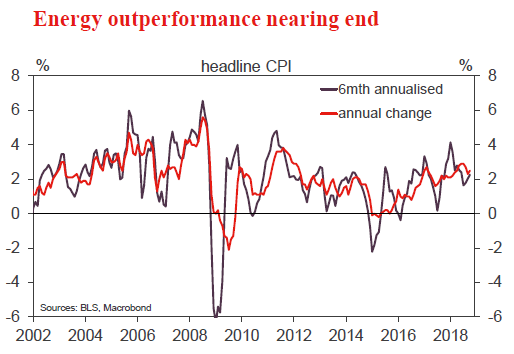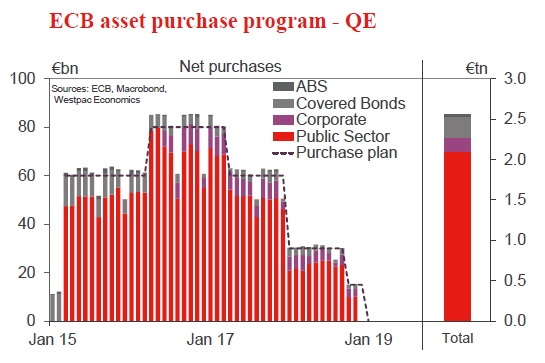Week beginning 10 December 2018
- Key market and economic views for 2019 and 2020.
- Australia: Westpac-MI consumer sentiment, AusChamber-Westpac survey, housing finance, RBA Assistant Governor Kent speaks, NAB business survey.
- NZ: Half-Year Fiscal and Economic Update, RBNZ Governor Orr testimony before Parliament, retail card spending, house prices and sales.
- China: retail sales, industrial production, fixed asset investment, CPI.
- Europe: ECB policy decision, flash PMI.
- UK: Parliamentary vote on Brexit.
- US: CPI, retail sales, flash PMI.
- Key economic & financial forecasts.
Information contained in this report current as at 7 December 2018.
Key Market and Economic Views for 2019 and 2020
Prospects for the RBA Cash Rate
Developments in this last week have significantly changed the “atmosphere” around the outlook for the RBA’s cash rate.
The RBA has been consistently signalling that growth in the Australian economy will remain comfortably above potential in both 2018 and 2019. It has also repeatedly speculated that while there is no immediate urgency to move rates, the next move was more likely to be up rather than down.
Westpac has been sceptical about both assertions maintaining its call that growth in 2019 was likely to be “around potential”, and that through both 2019 and 2020, the cash rate was expected to remain on hold.
To our knowledge, we have been the only forecaster consistently promoting that view with others, including markets, expecting higher rates through 2019 and beyond. As recently as last month, markets were positioned with a 75% probability for an RBA rate hike by end 2019.
As discussed below, the GDP report, which printed on December 5, is most likely to prompt a major review of the RBA’s growth forecasts with 2018 growth expected to be revised to 3% (only 0.25% above potential) and 2019 growth back at around potential.
With the Xmas break looming, these revisions are unlikely to be formalised before the next Statement on Monetary Policy on February 8.
Related to this likely change in forecasts is a more balanced approach to the outlook for rates. In a speech on December 6 (and during the Q&A session) Deputy Governor Debelle noted that “There is still scope for further reductions in the policy rate. It is the level of interest rates that matters and they can still move lower.” This sentiment is likely to see the Bank indicate a different approach to rates with the risks being evenly balanced.
Critically, the Bank will be assessing the impact of falling house prices and tighter credit on the real economy.
The Bank is not convinced about a significant wealth effect; is unsure about the “right” level of household debt in the economy; is unclear about the current scenario where the unemployment rate is falling while house prices are falling; and is uncertain about how the current house price cycle will evolve given that previous cycles have seen affordability restored through multiple rate cuts rather than specifically through price adjustments.
Given these uncertainties it would be reasonable to back away from the expectation that the next move in the cash rate will be up.
In addition, in 2019 the Australian economy will be challenged by the political uncertainty of an election campaign and the ongoing threats from a global economic slowdown.
On the other hand there continues to be optimism about jobs growth; consumer and business confidence; booming government infrastructure investment; strong services exports; and a likely substantial fiscal stimulus from the upcoming Commonwealth Budget on April 2.
A Surprise Domestic Growth Slowdown
Growth in the Australian economy slowed to 2.8% in the September quarter. There were a number of significant developments in the GDP report.
Firstly we saw the first “negative” on new dwelling construction in the quarter following a particularly strong first half. Westpac expects this will be the start of a long run of falls in residential construction reflecting the downturn in dwelling approvals and the expected further contraction in dwelling approvals as tight funding conditions and falling house price expectations deter new construction.
Secondly, we saw a particularly weak print on consumer spending reflecting weak income growth (real household disposable income was flat over the year to date) and a decade low savings rate.
Wages growth is lifting only very slowly while strong employment growth is expected to slow in 2019 as political uncertainty weighs on the confidence of business. There is also likely to be some wealth effect on consumption through 2018 H2 and 2019 as the impact of falling house prices on households’ balance sheets plays out.
Non-residential construction is also falling – down from the surge in activity we saw in 2017, although we expect this to stabilise through 2019.
Overall, we expect growth in 2018 will print around 3% with the 4% annualised momentum in the first half slowing to 2% in the second half. We expect growth to slow in 2019 to 2.6% following ongoing contraction from new dwelling construction; continuing below trend growth in consumer spending; and uncertainties around the Federal election and the global economy.
House prices will be important in 2019. Even though prices have fallen by 9.6% from their peak in Sydney and 5.8% in Melbourne, these adjustments follow cumulative increases in Sydney (40%) and Melbourne (32%) over the previous four years. Affordability is still stretched in both cities.
Unlike previous cycles where affordability was boosted by sharp reductions in interest rates and strong (4% wages growth) income growth, the necessary restoration of affordability in this cycle will need to come from prices.
The additional complication is that even if affordability has been restored and buyers are attracted back into the market, credit is being tightened by the banks. As we have recently seen in Perth, affordability can be restored but prices can still fall further if credit is tightened.
On the positive side there are other construction cycles which are likely to continue to boost growth. Government infrastructure spending, in particular, continues to lift; we are at the bottom of the mining investment cycle and positive prospects particularly around iron ore and lithium are boosting investment plans.
The September quarter GDP print will come as a disappointment to the Reserve Bank. Recall that in the Governor’s Statement on Tuesday, he noted that “one continuing source of uncertainty is the outlook for household consumption”.
Note that the Bank’s forecast for GDP growth in 2018 which appeared in the November Statement on Monetary Policy was 3.5%. With the first three quarters of the year totalling 2.2%, the December quarter would have to print growth of 1.3% (a 5.2% annualised growth pace) – a highly unlikely event. We can expect the Bank to lower its forecast for GDP growth in 2018 from 3.5% to 3.0% when it next releases its forecasts on February 8, 2019.
That forecast will then challenge the 2019 forecast of 3.25% which appeared in the November Statement. It was reasonable for the Bank to assume some slowing between 2018 and 2019 (Westpac’s growth forecast for 2019 has been 2.7%) particularly with a more clouded outlook for global growth and a likely accelerated contraction in residential investment. That would immediately push the likely 2019 forecast back to around Westpac’s forecast of 2.7%.
So, although we did not get a growth assessment from the Deputy Governor in his speech on Thursday, the GDP print is likely to change the Bank’s growth rhetoric of strongly above trend to slightly above trend drifting back to trend in 2019.
Westpac has consistently forecast that the cash rate would remain on hold through 2019 and 2020. If we are right that the Bank will revise down its growth forecasts on the basis of this result, then lower expected growth momentum going into 2020 may also temper the Bank’s attitude to rates in 2020 as well.
From our perspective, a central bank forecasting growth around trend rather than well above trend is much less likely to feel the “responsibility” to normalise rate settings.
The Market is Too Cautious on the Federal Funds Rate
With this domestic growth profile as a backdrop, we confirm our long held views that the Reserve Bank will keep the cash rate on hold through 2019 and 2020.
The RBA’s on hold decision will also be backed up by slowing global growth, particularly in 2020 when the US economy will slow back to trend growth of around 1.75% from an above trend 2.5% in 2019 and near 3% in 2018.
Furthermore, the first half of 2019 will see markedly faster growth than the second half when, in particular, the interest rate sensitive parts of the economy (housing and durables) will be weak and employment growth will slow. Despite the fading of the tax cuts, we believe rising wages and strong employment growth will boost household incomes in 2019, supporting solid consumer spending, particularly in services.
Although fiscal policy is currently scheduled to be tightening in late 2019, with a range of spending programs scheduled to expire, we expect that the authorities will find ways to extend them into the Presidential Election year (2020) taking some pressure off the economy and, in part, ensuring a soft landing for the US economy in 2020.
Unlike current market assessments of a potential inverse yield curve, we expect that the Federal Reserve will be able to pause earlier than has been experienced in previous cycles ensuring that soft landing.
With this growth profile in mind, we expect that the last hike from the FOMC will be in September 2019. By that time, employment growth will have slowed from 2% in the second half of 2018 to 1%, providing the FOMC with the opportunity to go on hold around a neutral setting – full employment; trend growth; and 2% inflation.
That timing implies four more hikes, beginning in December 2018. Markets are currently pricing one hike in December 2018 and only one more through 2019, indicating that we expect a sharp market surprise around the policy approach from the Fed.
In turn, this “surprise” is likely to see higher US bond rates and a stronger US dollar. We confirm our expectation that the US 10 year bond rate will lift to around 3.5% by the second half of 2019 and the USD Index will appreciate a further 3-4% by the September quarter.
The time for a sustainable fall in bond rates and the USD will be around the time of the FOMC pause, rather than the current circumstances when the US economy is growing near 3% and wage inflation risks are apparent.
Trade Policy and China are major risks
The biggest risk to this fairly benign outlook for the US economy is trade policy.
It seems unlikely that the Chinese authorities will be prepared to make the specific changes to their industry and trade policy that would specifically satisfy the US needs. These would include changes to forced technology transfer, intellectual property protection, non-tariff barriers, forced joint venture investment, cyber intrusions and government industry subsidies.
Consequently, trade disruptions are a certain theme through 2019 although President Trump and China are likely to find ways to avoid the US imposing tariffs on the remaining goods imported to the US from China that are not affected by tariff decisions to date. However, we believe a lift of the most recent 10% tariff on $200bn of trade could be increased to 25%.
We have seen that trade concerns have also weighed on the Chinese economy. Other more significant drags on Chinese growth have been winding back the shadow banking system and pollution policy. Credit policies to direct more growth into the regulated banking system; a more liberal approach to pollution policy; and direct fiscal stimulus will all be used to maintain a managed slowdown in China. We are targeting a 6.1% growth rate in 2019 from 6.4% in 2018.
Other regions are less important to the overall global view. Emerging markets will suffer under the weight of rising US interest rates and a higher USD. Japan will be preparing for the introduction of a new consumption tax and Europe will be impacted by the China/emerging markets slowdown; supplemented by Brexit; Italian instability; political unrest in France and Germany; and a gradual tightening of monetary policy as the ECB halts its balance sheet expansion from the beginning of 2019.
Australian Dollar and Commodities
Our RBA cash rate forecasts are lower than the market (which is still priced for a rate hike in 2020) whereas our federal funds rate forecasts are much higher.
That has implications for our views on the AUD with interest rate differentials continuing to favour the USD. We expect the AUD to fall to around USD 0.68 by September next year before recovering as the FOMC goes on hold.
Commodity prices will be the other key driver of the AUD.
On the supply side, an easing in China’s pollution policies will weigh on commodities, while we expect some loosening in the strict production guidelines at the majors to also support a lift in supply. With demand softer, we expect some modest weakness in commodity prices through 2019 and 2020.
The week that was
The lead-in to Australian GDP each quarter creates considerable expectation. In this instance, the outcome was a thorough disappointment, owing to weak consumer spending and incomes.
Following a 0.9% gain in the June quarter, GDP growth came in at just 0.3% in the three months to September. As a result, annual growth slowed from 3.1% (revised from 3.4%) to 2.8% – a rate best characterised as around trend.
The primary catalyst for this deceleration is the consumer, with consumption growth down from 0.9% in the June quarter to 0.3%. On both a six-month annualised and annual basis, consumer spending is decidedly below trend. Troublesome for the outlook, household incomes were weaker still, with real disposable income up just 1.0% over the past year. Ergo, even the sub-par spending of the three months to September required a decline in the savings rate to a new historic low of 2.4%. As an aside, the October retail sales print (also released this week) met modest expectations at 0.3%, but the detail was decidedly mixed. Clothing was strong and household goods solid, but spending at cafes and restaurants fell. Pointing to a potential impact from declining house prices on spending, in NSW where house price declines have been most severe, a 0.4% decline in October followed a 0.7% fall in September. Victoria and Queensland in contrast saw solid gains in the month.
Coming back to GDP, housing investment’s fall in the September quarter, in our mind, is the beginning of a trend decline in residential construction. Dwelling approvals are clearly off their highs, and supply and lending conditions are set to persist as significant headwinds for some time to come.
Though business investment also declined in the quarter, we see this as more noise than signal. This is, in part, because the weakness was concentrated in the notoriously volatile, mininglinked infrastructure category. Outside of mining, the pipeline of investment activity to come is significant and necessary. Like the current and expected strength in public sector investment, non-mining business investment is being aided by population growth – particularly in the south-eastern states.
From the RBA this week came two communications. As discussed by Chief Economist Bill Evans on the previous page, their comments and the disappointing Q3 GDP report are likely to see the RBA growth forecasts revised down towards trend in the February Statement on Monetary Policy.
Stepping offshore, US markets and the US economy appear to be taking diverging paths. While data on the economy remains unquestionably strong (outside of business investment), concern over the potential ill effects of trade and financial conditions are clearly mounting.
Having rallied on the weekend’s preliminary agreement between President Trump and President Xi, the S&P500 subsequently fell over 4% from Monday’s close to now on concerns over the detail of the agreement and subsequently, the potential for the arrest of Huawei’s CFO in Canada to scupper progress altogether.
Concern was also clearly evident in debt markets, the US 10-year yield falling from 2.97% at Monday’s close to a low of 2.82% during Thursday trade before it recovered back to near 2.90%. Note, just a month ago, the US 10-year reached a high of 3.23%. We remain of the view that the FOMC will continue to focus on the real economy and raise the federal funds rate to a peak of 3.125% at September 2019. But, as they have emphasised themselves, the risks bear careful assessment.
Into the weekend, the US will remain the centre of attention as the November employment report is received. Thereafter, the market’s focus will shift to the UK, with Parliament’s Brexit vote set for Tuesday 11 December.
As highlighted by Sterling’s jolt down to 1.2659 mid-week (now near 1.28), uncertainty over the matter is very, very high and may not be resolved next week.
Chart of the week: Q3 national accounts – household income
The September quarter was a difficult one for the Australian consumer, spending undershooting expectations, real disposable income essentially flat and a further decline in new savings.
On incomes, total nominal household disposable income rose by only 0.3%qtr with annual growth slowing to 2.8%yr. Adjusting for price changes (the consumer deflator rose 0.4%qtr), real household disposable income dipped 0.1%qtr with annual growth slowing to just 1.0%yr, having shown no net gain over the last three quarters.
Labour incomes made a decent 1% gain in the quarter, maintaining a 4.3% annual pace, but the flow through to disposable incomes was heavily offset by weakness in other components. The labour income gain breakdown relates to rising employment (+0.6%qtr) and average non-farm compensation per employee (+0.2%qtr). The state breakdown continues to show more evenly balanced growth across mining and non-mining states.
New Zealand: week ahead & data wrap
A changing leaderboard
Our latest Regional Roundup was released this week. It details why we think activity in Auckland has lagged many other parts of the country in recent times and equally importantly, why we expect this gap to start closing over the year ahead. In other developments, households across the country have benefitted from falling prices at the pump. This should mean a little more left in consumers’ wallets for other spending, and it’s also led to us to chip a bit off our nearterm inflation forecasts.
Our view remains that in aggregate the New Zealand economy will see a pickup in growth over the year ahead, underpinned by both a strong lift in government spending as well as a temporary improvement in the housing market on the back of recent falls in mortgage rates and a loosening in LVR lending restrictions.
One reason the Government has been able to plan such a significant lift in spending has been the healthy state of the fiscal accounts. This is likely to be a continuing theme when the Government releases its Half-Year Economic and Fiscal Update (HYEFU) on Thursday. It’s rare that the HYEFU is used to introduce new policies. However, there will be some announcements around the priorities for next year’s Budget, which will be the first produced under a ‘wellbeing’ framework.
We don’t expect to see significant changes to the forecasts compared to the May Budget. While we still regard the Treasury’s growth forecasts as too optimistic, the recent economic data has been solid, so is unlikely to persuade them to change their view at this time. The fiscal position is also coming from a strong starting point: the accounts for the year ended June 2018 revealed a much larger surplus and lower net debt than forecast, putting the Government well within its self-imposed fiscal responsibility rules.
However, those surprises won’t necessarily be carried forward into the projections for the next few years. Much of the ‘improvement’ was due to an unintentional shortfall in operational and capital spending. The fiscal accounts for the four months to October suggest that there has been some catch-up on last year’s underspend. If that continues, we could see a lower surplus forecast for this year, and little or no net change in the Government’s borrowing requirement. While this might mean we don’t see surplus projections press further into the black, it will still allow the Government to plough ahead with the significant spending plans it has already budgeted for.
While this lift in government spending will be felt across all regions (and in Wellington especially), the improvement in the housing market is likely to be felt particularly acutely in Auckland. The Auckland housing market has been treading water since mid-2016, so even a modest lift in prices could generate a bit of momentum in consumer spending in the region.
The other recent development that should give a bit of a boost to consumer spending in the near term are sharply lower petrol prices. Oil prices peaked in early October with Brent crude rising above $US 86/barrel. Since then prices have receded substantially, currently sitting at around $60/ barrel. Over the same period the NZ/USD has appreciated. For New Zealand consumers that means they’ve seen a noticeable drop in prices at the pump, from a peak of around $2.48/litre in early October to around $2.08/litre currently. With petrol costs gobbling up a smaller share of household budgets, there should be a little extra left to spend in other areas.
Lower petrol prices have also put downward pressure on our CPI forecasts for the December and March quarters. We’ve shaved 0.1 percentage points off our inflation forecast in each quarter. This would see annual inflation rise to 2.1% in the December quarter before falling back to 1.9% in March 2019. And while the Reserve Bank has always been adamant that it would look through a spike in oil prices when setting monetary policy, the lower near term inflation certainly does nothing to dent our view that the RBNZ will be content to sit on its hands until late 2020.
In rural regions, which have largely been outperforming their urban counterparts in recent times, growth is likely to remain firm, but is not expected to improve as noticeably over the coming year. One reason for this is the downward pressure on farm gate milk prices we’ve seen in recent months. Both Westpac and Fonterra have revised down their milk price forecast for this season. Our own forecast has been lowered to $6.10/KgMs, and Fonterra is now forecasting a range of $6-6.30 (previously $6.25-$6.50).
Slowing population growth is likely to become an increasing headwind for the New Zealand economy. Importantly for regional New Zealand, one driver of this slowdown is expected to be an increase in the number of New Zealanders moving across the Tasman. We think more Kiwis staying put has been an important factor behind regional population growth. As this starts to wane, it will weigh particularly heavily on activity in places such as the lower North Island and Otago where unusually strong population growth has been an important contributor to the outperformance of these regions in recent times.
In Auckland, slowing population growth and ongoing strength in residential building activity (this week saw a 1.2% lift in residential building in the September quarter) mean that Auckland will soon be building enough homes to keep up with population growth. Look a little further down the track and Auckland will be on the path to reducing its housing shortage.
Data Previews
Aus Oct housing finance (no.)
- Dec 10, Last: –1.0%, WBC f/c: 1.0%
- Mkt f/c: -0.4%, Range: -1.5% to 1.5%
Housing finance approvals continued to soften in September, the headline number of owner occupier loans down 1% but the value of loans notably weaker, owner occupier loans down –4.2% (–8% in the space of two months) and the value of investor loans down 2.8% (–18.1%yr). The combined total value of housing finance approvals including investors but excluding owner occupier refi, fell 3.7% to be down 14.2%yr.
Despite the weak lead in and a continued weakening in housing markets, the October update is expected to show a small 1% lift with Industry data pointing to a modest gain. That suggests some of the sharp decline through Aug- Sep relates to slower processing times as applications now involve more rigorous assessments of minimum expenses.
Aus Dec Westpac-MI Consumer Sentiment
- Dec 12 Last: 104.3
The Westpac Melbourne Institute Index of Consumer Sentiment rose 2.8% to 104.3 in November from 101.5 in October, extending a lift from softer reads in the previous three months. Sentiment has held up surprisingly well, particularly given the weakness in housing markets.
The December survey is in the field from December 3-8. This may be a sterner test for the consumer mood with a disappointing September quarter national accounts update and further declines in house prices in Sydney and Melbourne. Sentiment may also be influenced by a sharp sell-off in equities (ASX down 4.5% since the last survey and over 10% from August’s high), but more positively, a sharp fall in fuel prices (average pump prices down nearly 20% since the last survey).
Aus Q4 AusChamber-Westpac business survey
- Dec 13, Last: 66.5
The Australian Chamber-Westpac survey of the manufacturing sector provides a timely update on conditions in the sector and insights into economy-wide trends. The Actual Composite tracks a range of demand related measures including investment and employment. The Q4 survey was conducted from end October into December.
In Q3, the Actual Composite rose to 66.5 from 64.1 in June. Strength is centred on a lift in new orders, output employment and order backlog.
Manufacturing is benefitting from a rise in public infrastructure, non-mining business investment, and above par world growth with a relatively low AUD. However, there are likely to be spill-over effects from the drought in NSW and Queensland.
NZ Nov retail card spending
- Dec 11, Last: +0.1%, WBC f/c: -0.2%
Retail spending rose by only 0.1% In October. Underlying that muted gain, spending on fuel rose by 1.4% as petrol prices rose to high levels. For many households, this is likely to have constrained spending on other goods. In fact, spending in core (ex-fuel) categories was essentially flat.
We’re expecting to see a 0.2% drop in overall spending levels in November. That’s mainly due to the 10% drop in fuel prices over the month, which is pulling down nominal spending. However, that’s putting more money back in households’ wallets, which should support spending in other categories. Consequently, we’re forecasting a 0.4% rise in core (ex-fuel) spending.
The growing prevalence of ‘Black Friday’ sales may add to spending. However, the extent of this boost isn’t clear, with increased volumes balanced against big price discounts.
NZ Half-Year Fiscal and Economic Update
- Dec 13
The HYEFU provides an update of the Government’s economic and fiscal projections for the next five years. It will also provide some guidance on the priorities for next year’s “Wellbeing Budget”.
The June 2018 fiscal year saw a significantly larger surplus and lower net debt than forecast, putting the Government well within its Fiscal Responsibility Rules. Some of the surprise was due to a stronger than expected tax take, but much of it was due to an unintentional shortfall in spending. Since June we have seen some catch-up in spending, which could mean a lower surplus forecast for this year and a similar net borrowing requirement.
US Nov CPI and retail sales
- Dec 12, CPI, last 0.3%, WBC 0.0%
- Dec 14, retail sales, last 0.8%, WBC 0.4%
For headline inflation, energy prices have been a key support over the past year, supporting an acceleration from around 2.0%yr a year ago to a peak of 2.9%yr at Jun. However, with the price of oil having fallen sharply in recent months, headline inflation is reversing course. A flat outcome in Nov is likely to see the annual rate pull back to 2.2%yr. For core prices however, price growth is set to persist near 0.2% per month. In Nov, that should see core inflation also at 2.2%yr.
Retail sales growth was robust in Oct following two near-flat outcomes. As for inflation, the price of oil will be a negative in Nov. Abstracting from this effect, core retail should continue to grow at a solid pace, circa 0.7%. To this view, replacement purchases of cars post the 2018 hurricane season is an upside risk.
Eur Dec ECB policy decision (deposit rate)
- Dec 13, Last: -0.4%, WBC f/c: -0.4%
As we head into the December ECB meeting, all eyes will be on whether they confirm the end of net asset purchases and repeat their forward guidance that key policy rates will remain on hold “at least through the summer of 2019, and in any case for as long as necessary”.
The December meeting will include revised macroeconomic projections. President Draghi recently noted to European Parliament that “the data that have become available since my last visit in September have been somewhat weaker than expected”. However, he reiterated their belief that momentum will stabilise, citing normalising net exports and one-off factors driving the recent slowdown. As such we expect minor downward revisions to their near-term outlook.
Also of significance will be their characterisation of risks to their outlook. To date, the ECB have continued to note that risks are “broadly balanced”. The mentioned downside risks are global in nature and are described as prominent.




